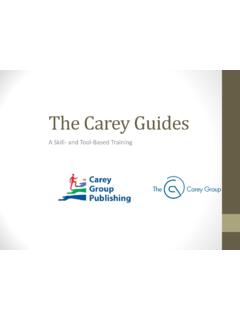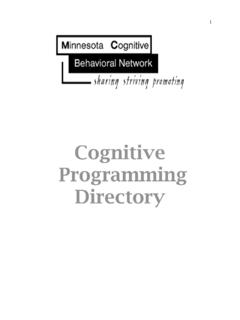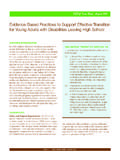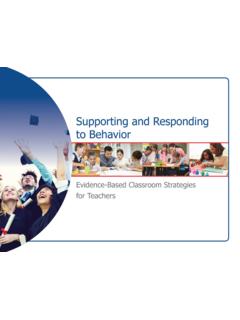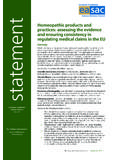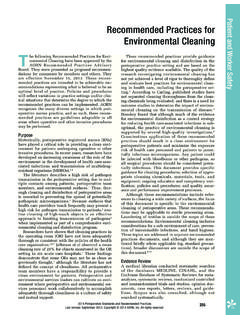Transcription of MACCAC Evidenced Based Practices
1 MACCAC Evidenced Based Practices Continuous Quality Improvement Plan Last Revised September 5, 2011 2 Introduction The evolution of evidence - Based Practices (EBP) in the field of corrections has significantly changed the methods by which we provide services to clients. Agencies are well on their way developing competencies in core EBP skill areas and, subsequently, are better equipped to promote positive changes in their client populations. The application of Motivational Interviewing, Effective Alliance, Risk Assessment, Case Planning, and Cognitive Interventions is essential to the success of EBP implementation. However, simply launching these initiatives is not enough. Agencies must invest in sufficient staff training, reinforce methods of continuous improvement, and measure outcomes in order to assure quality services and programming.
2 Research shows that when delivered with fidelity, evidence - Based Practices will enhance public safety through sustained reductions in recidivism. The Minnesota Association Community Corrections Act Counties ( MACCAC ) EBP Quality Improvement Work Group was established to assemble known elements of quality assurance into a format designed to promote agency alignment on a state-wide basis. What follows is a macro-level description of significant elements of a QA plan as it concerns overall outcomes and internal processes. Findings suggest t hat the following overarching standards must be in place to adequately initiate and support an EBP culture within an organization: The organization maintains a comprehensive staff development program.
3 Staff and supervisors receive initial training and annual booster sessions on key service components from qualified instructors. The organization exposes staff to continuous opportunities to learn and practice through peer review, coaching, supervisor observations, booster sessions, skills training, etc. The organization routinely evaluates staff Practices . Administrators and supervisors consistently monitor services and procedural compliance on an agency level. A systematic approach to case auditing and individual employee performance expectations are EBP-specific. The Continuous Quality Improvement (CQI) document is divided into five phases. Within each phase, there are five Evidenced - Based Practices listed that include: (a) effective alliance; (b) motivational interviewing; (c) risk assessments; (d) case plans; and (e) cognitive behavior skill development.
4 Phase One is designed to measure and prepare your agency for implementing Evidenced - Based Practices . Each MACCAC agency is expected to report all of the objectives listed in Phase One within their comprehensive plan. This ensures that agencies have set a strong foundation in which their efforts in EBP can be successful. 3 In Phase Two, the outcomes are designed to measure adequate training among staff in the five EBP principles and ensure the agency has put a process in place for measuring staff's use of EBP skills. Phase Three is designed to have each agency measure staff s quality in delivering EBP principles with fidelity. In Phase Four, the agency is expected to conduct a retrospective look at its outcomes and Quality Improvement processes to see if adjustments need to be made.
5 The focus of Phase Five is to measure the agency s overall implementation of EBP Practices department- wide while maintaining fidelity. In Phases Two, Three and Five, each EBP principle is broken out by objectives, data baseline, target, and outcome. The objectives are defined as core operating principles for implementing EBP with fidelity. The agency sets the data benchmark Based on their current status with regard to implementation of an EBP principle, while the target is where they hope to be after training efforts and working with staff in the delivery of EBP. The agency outcomes are defined as how the organization did in comparison to the target. With flexibility in target and outcomes, this allows each agency to set the pace and expectations Based on resources available to support implementing EBP.
6 After reporting on Phase One within the comprehensive plan, each MACCAC agency will be expected to report in future plans the target outcomes starting with Phase Two and progressing to Phases Three through Five Based on competency and meeting target objectives. Within each phase and EBP principle, agencies are expected to report on all outcomes listed as mandatory. However, agencies have the choice to report on optional outcomes or other outcomes listed in additional phases Based on organizational competency achievement of an EBP principle. Many agencies have a strong interest to implement evidence - Based Practices with fidelity but lack the resources to internally measure, collect data, and support fidelity in the manner suggested in this CQI plan.
7 Evaluating staff Practices has mainly been a supervisory responsibility in our field. The quality improvement measures proposed in this plan are suggested to provide a road map for agencies to move forward, and yet the writers acknowledge there are many limitations regarding each individual agency s ability to evaluate staff Practices in a manner that is evidence - Based . 4 Phase One-Agency Preparedness Vision: MACCAC agencies are prepared to foster EBP with quality assurance as a priority. Objectives Narrative Update Assess the agency s mission/vision and operating principles/policies for alignment with EBP Practices Conduct an organizational assessment and evaluate the culture/structure support for implementation of EBP Develop an EBP plan to guide implementation strategies and progress Ensure staff s participation in EBP through communication strategies and/or involvement in a task force Develop a plan that outlines methodology for tracking outcomes Define actual outcomes to establish a baseline and to establish a process to measure outcomes annually Ensure hiring strategies and performance expectations are aligned with EBP 5 PHASE TWO - EBP Implementation with Quality Improvement Measures Phase
8 Two-Effective Alliance Vision: All agents are proficient in professional, effective alliance techniques. Objectives Agency Determined Data/Benchmarks/Baseline Target Agency Outcomes Define agent/client relationship Establish standards for effective alliance as adopted at the agency level Train agents on the 14 effective alliance traits Implement semi-annual boosters Implement an offender survey tool Establish supervisory assessment/audit plan Launch direct observation ( Example) 23% of agents are familiar with 14 traits and use them in their interactions with clients 10 % of corrections staff have completed booster sessions. 10 % of staff have been observed to assess effective alliance skills Effective alliance client surveys were completed on 5 % of corrections staff Mandatory: XXX% of agents are trained in effective alliance XXX% of corrections staff have completed booster sessions XXX% of staff have been observed to assess effective alliance skills Mandatory: (Example) 50% of agents are trained in effective alliance 35 % of corrections staff have completed booster sessions 25% of staff have been observed to assess effective alliance skills Optional: Effective alliance client surveys were completed on XXX % of corrections staff Optional.
9 Effective alliance client surveys were completed on 10% of corrections staff 6 Phase Two-Motivational Interviewing Vision: All designated probation & corrections officers effectively engage the client in targeting those behaviors and criminogenic needs that impact recidivism. Objectives Agency Determined Data/Benchmarks Target Agency Outcomes Establish standards for MI as adopted at the agency level Provide training for all staff on MI by certified trainers Establish supervisory expectations for coaching staff Continue applied skill practice and feedback in order to retain MI skills TBD Mandatory: XXX% of targeted staff receive the initial MI training by a certified trainer using best Practices curriculum ( Current standard is 32 hours) XXX% of targeted staff attend yearly booster trainings XXX% of corrections staff are assessed by an evaluation method including observation TBD Optional.
10 XXX% of agency s supervisors receive the initial MI training by a certified trainer and curriculum 7 PHASE TWO - EBP Implementation with Quality Improvement Measures Phase Two-Risk Assessment Vision: All targeted clients criminogenic risk & needs factors are properly assessed. Objectives Agency Determined Data/Benchmarks Target Agency Outcomes Establish standards for risk assessment as adopted at the agency level Implement an initial criminogenic risk/needs assessment on targeted cases A pre-screening tool is utilized on clients who otherwise would not receive an initial risk/needs assessment Persons yielding a high score are referred for a full assessment Appropriate trailer assessments are completed on clients involving sex crimes and/or domestic violence A re-assessment of criminogenic risk/needs is completed on clients with an active case plan Risk/needs scores drive level of supervision Professional override decisions are limited to exceptional situations TBD Mandatory.


